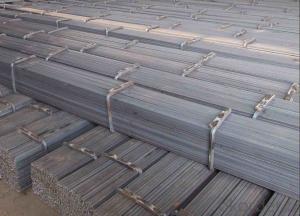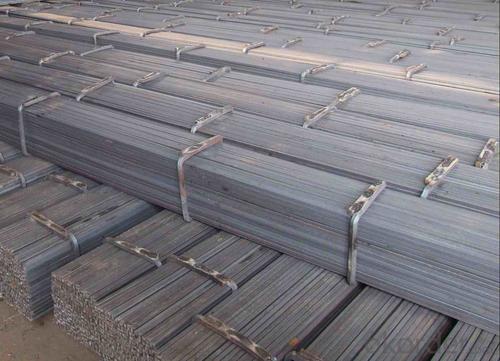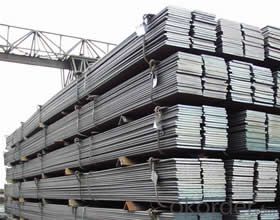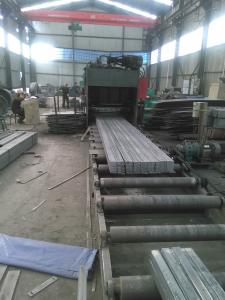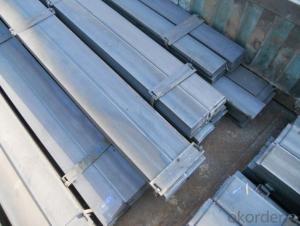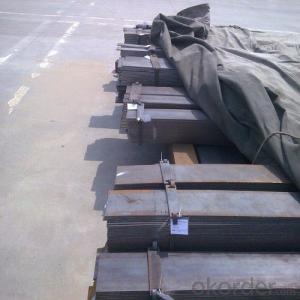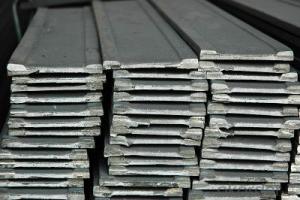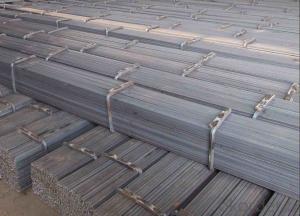high quality flat bar GB Q235 or wide falt bar
- Loading Port:
- Tianjin
- Payment Terms:
- TT OR LC
- Min Order Qty:
- 25 m.t.
- Supply Capability:
- 20000 m.t./month
OKorder Service Pledge
OKorder Financial Service
You Might Also Like
lat bar Details:
| Minimum Order Quantity: | Unit: | m.t. | Loading Port: | ||
| Supply Ability: | 10000 | Payment Terms: | Package: | Steel Packing |
Product Description:
Product Description:
Specification of Mild Steel Flat Bar
Commodity: Mild Steel Flat Bar
Standard: GB;JIS
Material: Q195-235;SS400
Brand name: FLATSPACE
Origin place: China
Thickness: 3mm-30mm
Width:20mm-200mm
Length: Max 12m
Certification: SGS/BV
Chemical composition of Q235
Alloy No | Grade | Element(%) | ||||
C | Mn | S | P | Si | ||
Q235 | B | 0.12—0.20 | 0.3—0.7 | ≤0.045 | ≤0.045 | ≤0.3 |
Physical properties of Q235
Alloy No | Grade | Yielding strength point(Mpa) | Tensile strength (Mpa) | Elongation after fracture(%) | ||||||
Thickness (mm) | Thickness (mm) | |||||||||
≤16 | >16--40 | >40--60 | >60--100 | ≤16 | >16--40 | >40--60 | >60--100 | |||
≥ | ≥ | |||||||||
Q235 | B | 235 | 225 | 215 | 205 | 375--500 | 26 | 25 | 24 | 23 |
Usage/Applications of Mild Steel Flat Bar
Widely used for construction, Machinery manufacturing, Iron tower steel structure, Shipbuilding; Steel grating, Staircase, Bridge, Viaduct, Railway spare parts, Boilers making etc.
Packaging & Delivery of Mild Steel Flat Bar
Packaging Details: The Mild Steel Flat Bars are packed in bundles and loaded in 20 feet/40 feet container, or shipped by bulk cargo ,also we can do as customer's requirements.
Delivery Details:30~45 days upon the receipt of buyer payment by T.T. or L/C.
Production Flow of Mild Steel Flat Bar
The Mild steel flat bar is made through three processes:
1.Feeding the material: Feeding the row material (the steel plate) to Slitting Line.
2.Slitting:The steel plate would be slitted into expected width by lengthways cutter.
3. Leveled and cutting: The plat bar would be ground into level by the grinder and then cut into required length
- Q: What is the maximum weight steel flat bars can support?
- The maximum weight that steel flat bars can support depends on various factors such as the dimensions of the bar, the type of steel used, and the specific application or load conditions. Steel flat bars are designed to provide strength and stability in structural and load-bearing applications. To determine the maximum weight a steel flat bar can support, engineers and designers typically refer to load tables and charts provided by steel manufacturers or industry standards. These tables consider factors such as the bar's width, thickness, length, and the type of steel used. They also take into account factors such as the type of load (static or dynamic), the distribution of the load, and the safety factor required for the application. It is essential to consult these load tables or seek professional engineering advice to ensure the steel flat bar is appropriately sized and can safely support the intended weight. Improperly estimating the maximum weight a steel flat bar can support may lead to structural failure, safety hazards, or damage to the material or surrounding structures.
- Q: Are steel flat bars suitable for welding with other metals?
- Yes, steel flat bars are suitable for welding with other metals. Welding steel flat bars with other metals is a common practice in various industries as steel offers good compatibility and excellent weldability with a wide range of metals, including aluminum, stainless steel, and other ferrous and non-ferrous materials. However, it is important to consider the specific properties and compatibility of the metals being welded together, as well as to follow proper welding procedures and techniques to ensure a strong and durable bond.
- Q: Can steel flat bars be coated with anti-slip materials?
- Coating steel flat bars with anti-slip materials is indeed possible. There are multiple techniques and substances accessible for achieving an anti-slip surface on steel flat bars. One commonly utilized substance is a non-slip epoxy coating that incorporates aggregates like aluminum oxide or silicon carbide. These aggregates generate a rough texture that improves grip and prevents slips or falls. Moreover, materials such as rubber, vinyl, or adhesive tapes with anti-slip characteristics can also be employed to enhance the slip resistance of steel flat bars. These coatings prove advantageous in locations where slip hazards may arise, such as walkways, ramps, stairs, or industrial environments. Applying anti-slip materials to steel flat bars in the appropriate manner ensures heightened safety and minimizes the likelihood of accidents across various settings.
- Q: Can steel flat bars be used for making frames or supports for signs?
- Frames or supports for signs can indeed be made using steel flat bars. These bars possess both versatility and strength, which makes them excellent for providing structural support. Custom frames of different shapes and sizes can be easily crafted by cutting, bending, and welding these bars. Steel's robust nature allows it to withstand harsh weather conditions, making it suitable for outdoor applications and ensuring long-lasting durability. Moreover, to enhance their aesthetic appeal and protect against corrosion, steel flat bars can be painted or coated. All in all, due to their strength, versatility, and ability to withstand various environmental factors, steel flat bars are widely chosen for constructing frames or supports for signs.
- Q: Can steel flat bars be used for manufacturing hand tools?
- Hand tools can indeed be manufactured using steel flat bars. Steel is widely utilized in the production of hand tools because of its robustness, longevity, and ability to withstand wear and tear. By shaping, cutting, and forging steel flat bars, a diverse array of hand tool designs, including wrenches, chisels, screwdrivers, and hammers, can be crafted. The flat nature of these bars facilitates effortless machining and shaping, rendering them an ideal option for hand tool manufacturing. Moreover, steel boasts exceptional mechanical properties, enabling it to endure significant stress and furnish users with a sturdy grip.
- Q: What are the advantages of using steel flat bars over other materials?
- There are several advantages of using steel flat bars over other materials. Firstly, steel flat bars are known for their exceptional strength and durability. Steel is one of the strongest materials available, making it suitable for applications that require high load-bearing capacity. This strength allows steel flat bars to withstand heavy weights and resist bending or breaking under pressure. Secondly, steel flat bars have excellent corrosion resistance. They can withstand exposure to various environmental conditions, including moisture, chemicals, and extreme temperatures, without deteriorating or rusting. This corrosion resistance is especially crucial in outdoor or industrial environments, where other materials may not be as resilient. Another advantage of steel flat bars is their versatility. They can be easily fabricated and customized to meet specific project requirements. Steel flat bars can be cut, welded, bent, or machined into various shapes and sizes, allowing for flexibility in design and application. This adaptability makes steel flat bars suitable for a wide range of industries, including construction, manufacturing, and automotive. Moreover, steel flat bars offer cost-effectiveness in the long run. While the initial investment in steel may be higher than some other materials, its durability and low maintenance requirements make it a cost-effective choice in the long term. Steel flat bars have a long lifespan, reducing the need for frequent replacements or repairs, which can save both time and money. Lastly, steel flat bars have excellent recyclability. Steel is one of the most recycled materials globally, and steel flat bars can be recycled and reused multiple times without losing their properties. This makes steel flat bars an environmentally friendly choice, contributing to sustainable practices and reducing the overall carbon footprint. Overall, the advantages of using steel flat bars over other materials include exceptional strength, corrosion resistance, versatility, cost-effectiveness, and recyclability. These qualities make steel flat bars a reliable and sustainable option for various applications.
- Q: How do you determine the tensile strength of a steel flat bar?
- To determine the tensile strength of a steel flat bar, you would typically perform a tensile test. This test involves subjecting a sample of the steel flat bar to a gradually increasing tensile force until it reaches its breaking point. The force required to break the sample is then recorded and used to calculate the tensile strength. First, you would obtain a representative sample of the steel flat bar. The sample should be a sufficient length to allow for gripping and testing without any irregularities or defects. It is important to ensure that the sample is prepared in accordance with the applicable standards and guidelines to obtain accurate results. Next, the sample is typically placed into a universal testing machine, which has the capability to apply a controlled tensile force to the sample. The machine is equipped with fixtures that securely hold the sample, ensuring it does not slip or become misaligned during the test. The test begins by slowly applying a tensile force to the sample, gradually increasing it until the sample breaks. The machine records the applied force at regular intervals, allowing for the construction of a stress-strain curve. This curve provides valuable information about the material's behavior under tension and helps to determine its tensile strength. Once the sample breaks, the maximum force applied before failure is recorded. This force is divided by the cross-sectional area of the sample to obtain the tensile strength. The cross-sectional area is typically determined by measuring the width and thickness of the sample using precise instruments. It is worth mentioning that the tensile strength may vary along the length of a steel flat bar due to factors such as variations in composition, heat treatment, or manufacturing processes. Therefore, it is advisable to take multiple samples from different sections of the bar to obtain representative results. In conclusion, determining the tensile strength of a steel flat bar involves performing a tensile test on a representative sample. This test involves gradually applying a tensile force until the sample breaks, recording the maximum force applied, and dividing it by the cross-sectional area of the sample to calculate the tensile strength.
- Q: Can steel flat bars be used in the manufacturing of tools?
- Yes, steel flat bars can be used in the manufacturing of tools. Steel is a widely used material in tool manufacturing due to its strength, durability, and versatility. Steel flat bars can be easily machined, shaped, and heat-treated to create various types of tools such as wrenches, chisels, scrapers, and cutting tools. These flat bars can be cut, drilled, and welded to form the desired tool shape, and their inherent strength allows them to withstand the forces and pressures exerted during tool use. Steel flat bars also provide good resistance to wear, ensuring that the tools can withstand repeated use without losing their functionality. Overall, steel flat bars are a reliable and commonly used material in the manufacturing of tools.
- Q: Do steel flat bars have a specific surface hardness?
- Steel flat bars possess a distinct surface hardness, which is typically influenced by the particular grade or type of steel employed during their production. The hardness levels of different steel varieties differ, and these may be assessed with the aid of various scales, such as the Rockwell hardness scale. The surface hardness of steel flat bars holds significance, as it directly impacts their capacity to withstand wear, abrasion, and deformation. For achieving optimal performance and durability, it becomes vital to meticulously choose steel flat bars with the desired surface hardness grade, specific to the intended applications.
- Q: What are the common uses of steel flat bars in construction?
- Steel flat bars are commonly used in construction for various purposes such as providing structural support, reinforcing concrete structures, creating frames for doors and windows, constructing fences and railings, and fabricating brackets and supports for various building elements.
Send your message to us
high quality flat bar GB Q235 or wide falt bar
- Loading Port:
- Tianjin
- Payment Terms:
- TT OR LC
- Min Order Qty:
- 25 m.t.
- Supply Capability:
- 20000 m.t./month
OKorder Service Pledge
OKorder Financial Service
Similar products
Hot products
Hot Searches
Related keywords
